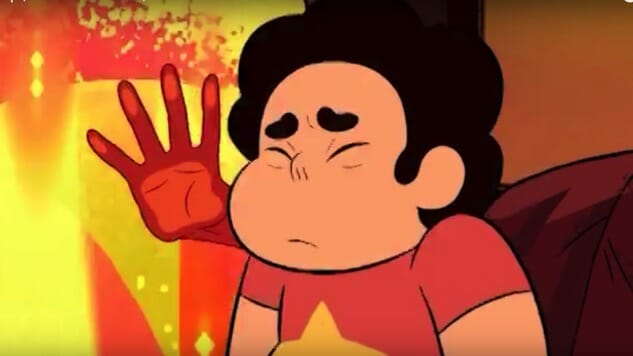
We’re in the midst of Peak TV, so if you haven’t been paying attention to Cartoon Network, you’re forgiven. But your ignorance ends today.
The first news item I ever wrote for Paste, at the very beginning of what would be a four-month internship, announced the return of Steven Universe from hiatus in January with a weeklong event. Looking back, I don’t think I sold it quite well enough. Now that the show is returning to the air on Thursday for a four-week special called “In Too Deep” and a subsequent “Summer of Steven” that promises regularly scheduled new episodes (a rarity for various reasons), I’m going to make it my duty to convert as many of you into fans as possible.
Like WGN’s Underground has with my wonderful editor Shannon Houston, Steven Universe has found a special place in my heart, and despite it ostensibly being a kids’ show (a misnomer in itself—I’d use “all ages”), there are a number of reasons why it needs to find a place in your heart, too. And you’ve got room for it: each episode is only 11 minutes long.
1. Its overarching plot is genuinely compelling.
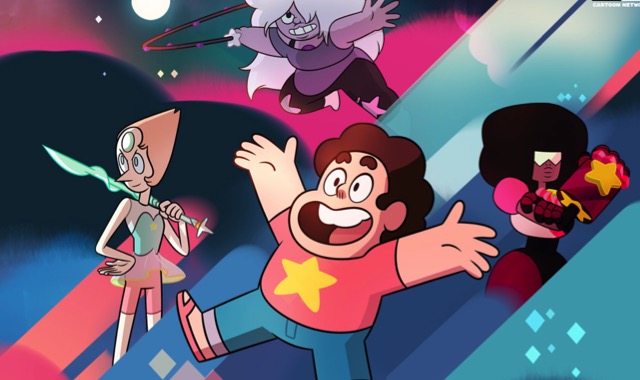
Not many kids’ shows have the balls to pull off a serialized story arc, not only because kids have short attention spans but also because Cartoon Network and its competitors are reliant on reruns, and that gets tough when you need to have seen early episodes to understand later ones. But Steven Universe can get away with it because the show’s plot has developed so well that it’s become appointment television for children (and their parents, and other adult fans).
In a nutshell, here’s the deal: 14-year-old Steven Universe is the offspring of a human man and an alien from a race called the Gems, who are sentient mineral crystals capable of generating humanoid bodies. Steven’s under the protection and guardianship of the Crystal Gems, three friends of his late mother Rose Quartz—the stoic, wry Garnet, the endearingly neurotic Pearl, and the fun, immature Amethyst—as he simultaneously deals with the advent of human adolescence and the discovery of his mother’s Crystal Gem legacy. The group’s perfect life in Beach City (somewhere on the Atlantic coast) gets royally screwed when Gems from the Gem homeworld come back to finish what they started five thousand years ago: a colonization of Earth that would kill all humans. The Crystal Gems rebelled back then, under the leadership of Rose, and they’ll continue to rebel now.
This all probably sounds really weird if you’re uninitiated, but it’s worth the time to start from the beginning and let the show and its characters build up. Unlike most cartoons, Steven Universe has actual stakes that grow more dire over time—eventually, things get to the point where the whole damn Earth is in imminent danger of being blown up—and that makes Steven and the Crystal Gems painfully aware of their own mortality. The idea of death doesn’t dominate the show, because no child would want to watch something so dark, but it’s always lurking in the background, and the main characters’ responses to it (the Crystal Gems have all survived a brutal war) make them far more realistic, relatable and fascinating than your average animated character. You buy into their struggle; you want them to succeed in achieving their goals. And because you know they’re not immune to death, you care about them more, and you share their fear that they’ll die. Will that actually happen in a children’s show? Probably not. But it’s the thought that counts.
2. Its creator cut her teeth on Adventure Time.
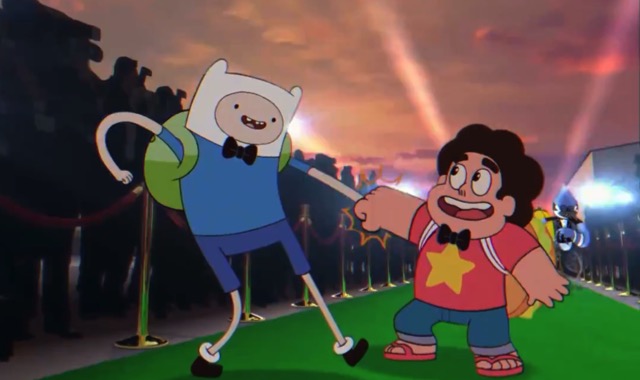
Adventure Time is one of the few kids’ cartoons that has entered the broader pop culture lexicon; Ryan Reynolds’ Deadpool even honored the show with his wristwatch. A large part of its intergenerational appeal has stemmed from its surreal animation and philosophical themes—perfect fodder for stoners and children alike—but the show’s most acclaimed work has come from its superb character development. And one of the key contributors in that field was Rebecca Sugar, who joined Adventure Time during its inaugural season, and left after five seasons to work on her own creation, Steven Universe, full-time.
Name a poignant moment in the former, and Sugar was likely behind it. Her work on the relationship between Ice King and Marceline the Vampire Queen added heartrending tragedy to the show’s otherwise carefree milieu; Sugar-led episodes such as “I Remember You” and “Simon and Marcy” rank among Adventure Time’s very best. She also wrote much of the budding relationship between Finn the Human and Flame Princess, and she laid the groundwork for what many fans think is a past same-sex romance between Marceline and Princess Bubblegum. For those of you who don’t watch Adventure Time and have no idea what any of that means, let me sum up Sugar’s role on the show in simpler terms: she gave it heart and served as its greatest understanding of love. Its expansive creative canvas gave her plenty of room to experiment with more mature themes, and by the time she committed herself to Steven Universe, she had perfected the art of distilling difficult, nuanced messages into language that even grade-school children can easily understand—and without losing meaning in translation.
On the other side of the coin, Sugar’s Adventure Time experience has clearly taught her how to inject humor for adults into a kids’ show. Steven Universe garners critical acclaim for its mature themes, but it’s also consistently and sneakily hilarious.
3. It features incredible original songs—and great vocal talent singing them.
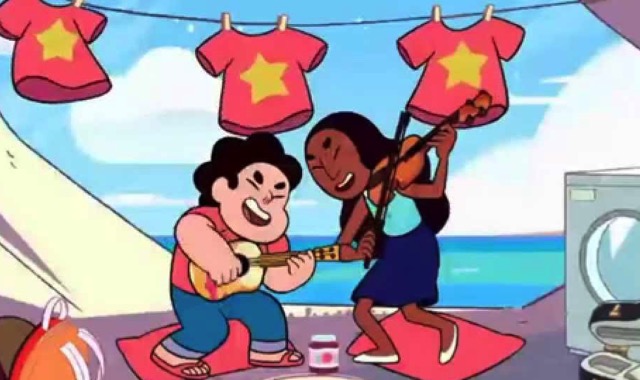
One of Sugar’s other great strengths is her songwriting ability, which she first displayed on Adventure Time and brought in full force to Steven Universe. Her style ranges all over the place, but it typically finds its home in either cutesy, Paul McCartney-esque acoustic tunes (often written on ukulele), or bold, musical theater-inspired ballads. She can do both exceedingly well.
No show on the air today, save perhaps Crazy Ex-Girlfriend, uses songs as well to express emotion and character as does Steven Universe. The titular Steven, voiced ably by Zach Callison, is an ever-optimistic protagonist who sees the best in everyone at all times, and his songs often burst with joie de vivre that helps his friends overcome the difficulties in their lives. For an example that doesn’t require much context, check out Jam Buddies, a whimsical duet Steven plays with his best friend Connie, and try to tell me you don’t hear strains of White Album-era Beatles.
The other songs’ style varies depending upon the character singing them. Steven’s dad Greg, a washed-up rocker, brings some guitar-heavy material into the fold; the duet he sings with his late wife in Season Two’s “We Need To Talk” is one of the steamiest moments you’ll ever see in a kids’ show. Pearl, played by Broadway veteran Deedee Magno, gets the types of thoughtful, emotional songs you’d expect to hear from an insecure, unrequited lover in a stage musical. And Garnet is voice by Estelle—the British singer who won a Grammy for “American Boy” in 2008. Her partly-rapped, partly-sung “Stronger Than You,” from Steven Universe’s Season One finale, is not only a badass musical narration for the fight between Garnet and a Gem warrior from the Homeworld; it’s also a genuinely catchy pop song that could probably get away with being released as an Estelle B-side, or deluxe track.
4. Its take on gender and sexuality is complex, mature, and the boldest thing on television today.
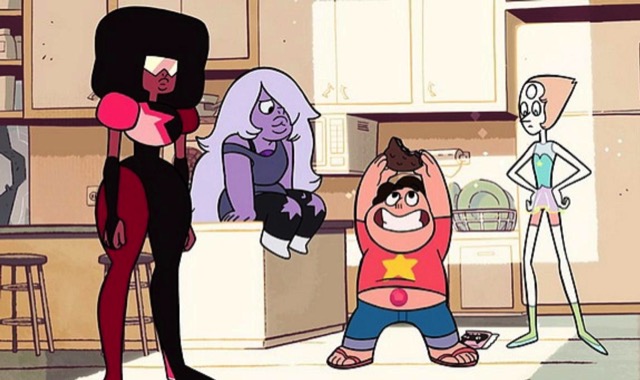
The first thing you notice when you start watching Steven Universe is just how many of the lead characters are women. Though Sugar has clarified that Gems are sexless and genderless, they all appear as females. This alone is a groundbreaking step, not just in cartoons but on television as a whole. By making all of the show’s most powerful people female, Sugar has created a world wherein women can be explored as characters with agency, complex personalities, and motives outside of ending up with a dream man. Steven is effectively raised by the Crystal Gems—his dad does provide him with important perspective and grounds him in humanity, but he’s a relative slacker who probably couldn’t raise a half-alien child alone—and that means he looks up to the powerful women in his life for guidance, education, and comfort. Steven also breaks the typical bildungsroman trope of the young warrior trying to live up to his father; it’s his mother who was the all-powerful fighter, the leader of a successful rebellion, but who was also legendary in her empathy, capacity for love, and other “feminine” traits. That Steven’s arc trends toward his coming into Rose Quartz’s legacy speaks to the heroic potential of women—real women, not just Amazon-type fighters—and shows that there’s more to being strong than just physical strength.
But Steven Universe does more than just put women in the spotlight; it showcases and normalizes gender-queer love better than any other show on television. Pearl has long harbored romantic feelings for Rose Quartz (a sensual dance between the two was controversially censored in Britain this past January). Garnet is the literal embodiment of a same-sex romantic relationship—she’s composed of two smaller Gems fused together into one body. And the very concept of fusion itself (all Gems can do it) is a metaphor for different types of love and sex, which are discussed with astounding candor over the show’s course. If you’re looking for hope that the next generation of Americans will be more open-minded to love in whatever form it takes, Steven Universe has your back.
5. It will make you love life.
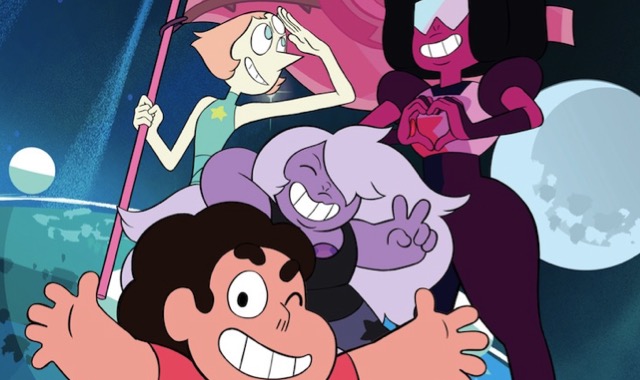
Love is the central theme of Steven Universe—not just the romantic love already discussed, but love of everything about life on Earth. Over the course of the show, it’s revealed that the Gems who want to conquer our planet come from a rigidly structured, collectivist, emotionless society dominated by cold reason. To them, fusion is for battle purposes only; imperfect, noncrystalline life forms like humans deserve to be eliminated, and their irrational concerns serve no purpose; Earth is a stockpile of resources that can be used to create more Gems and extend the empire’s reach. Steven and the Crystal Gems meet a handful of characters with this perspective, most notably the show’s ascendant star Peridot, and the contrast is illuminating.
It’s not as though Steven Universe treats life on Earth as a panacea. The Crystal Gems are effectively intergalactic fugitives. Together with Steven they deal with heartbreak, disappointment, and the other travails that come with existence, and the show doesn’t shy away from exploring these concerns in depth. But despite their circumstances, the protagonists never lose their ability to find humor, joy, or self-determined purpose—and they never lose sight of the fact that these abilities come from the phenomenon of life on Earth itself. Every moment of Steven Universe affirms life as it happens, the good and the bad, and bursts with hope for a better future to be built out of the peaks and valleys of the present.
That’s why Paste’s reviews of Steven Universe are going to take the form of lists delineating the ways each episode made us love life. Whether it be a brutally funny joke, a particularly poignant song or some spectacular and unexpected character growth, Rebecca Sugar and company are pretty much guaranteed to leave you feeling happier about the mere fact of existence, every time, and I look forward to sharing that experience with you.
Steven Universe returns to the air on Thursday at 7:00 p.m. Eastern. Watch it. And then go to Hulu and catch up on everything you’ve been missing.